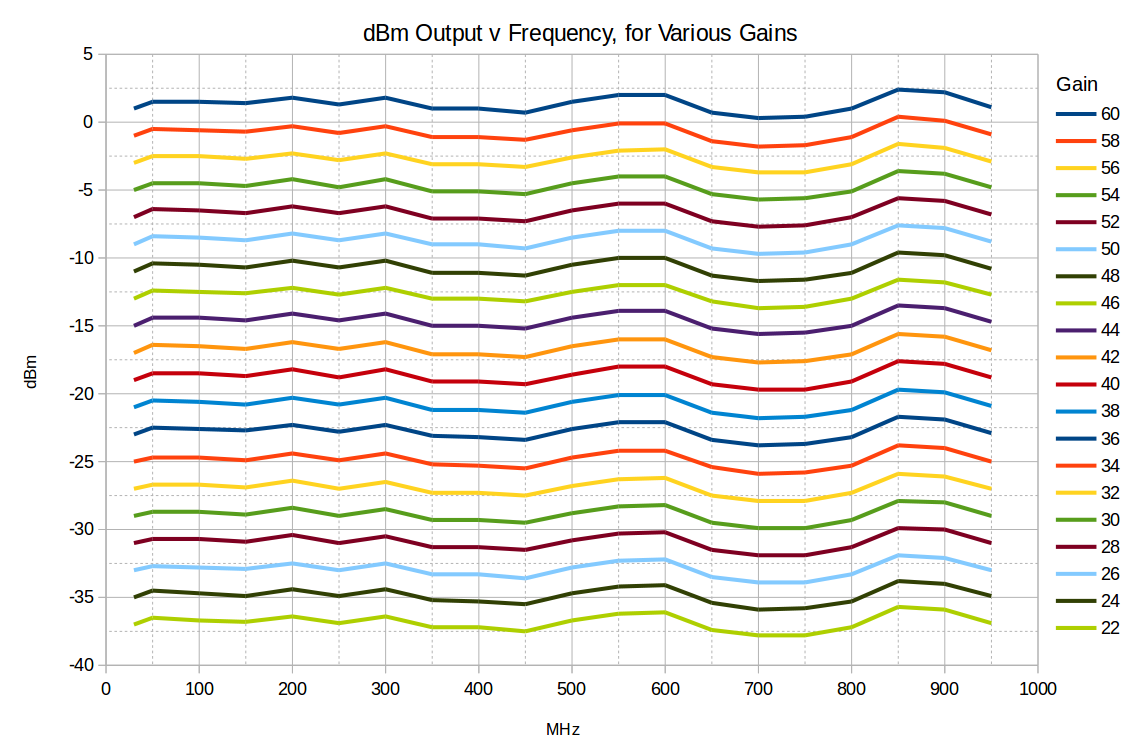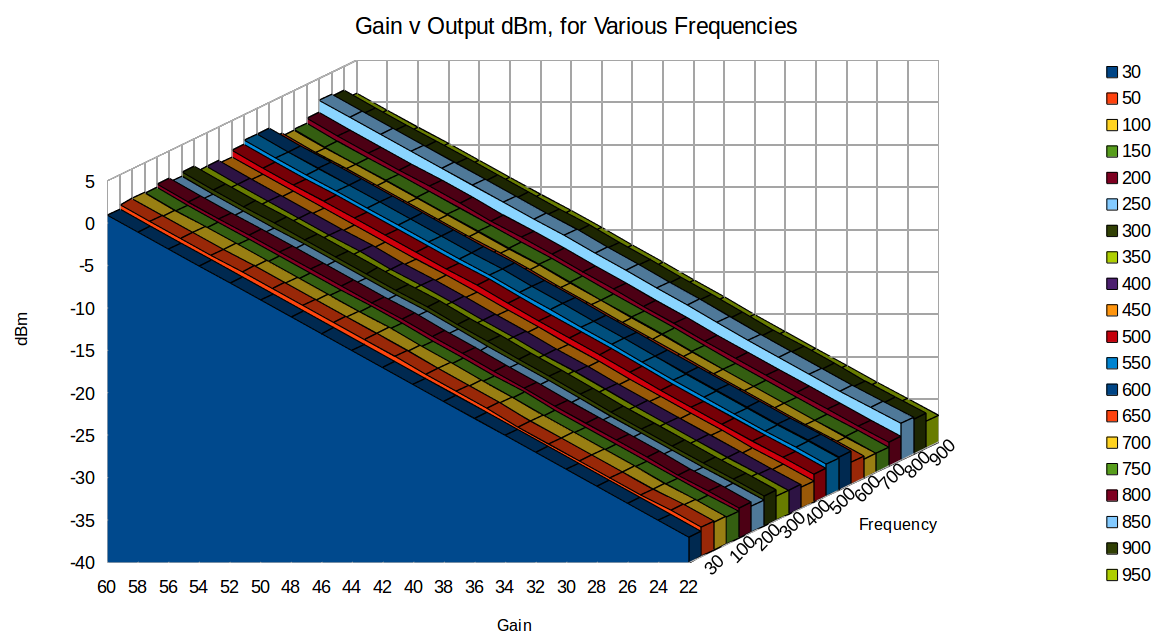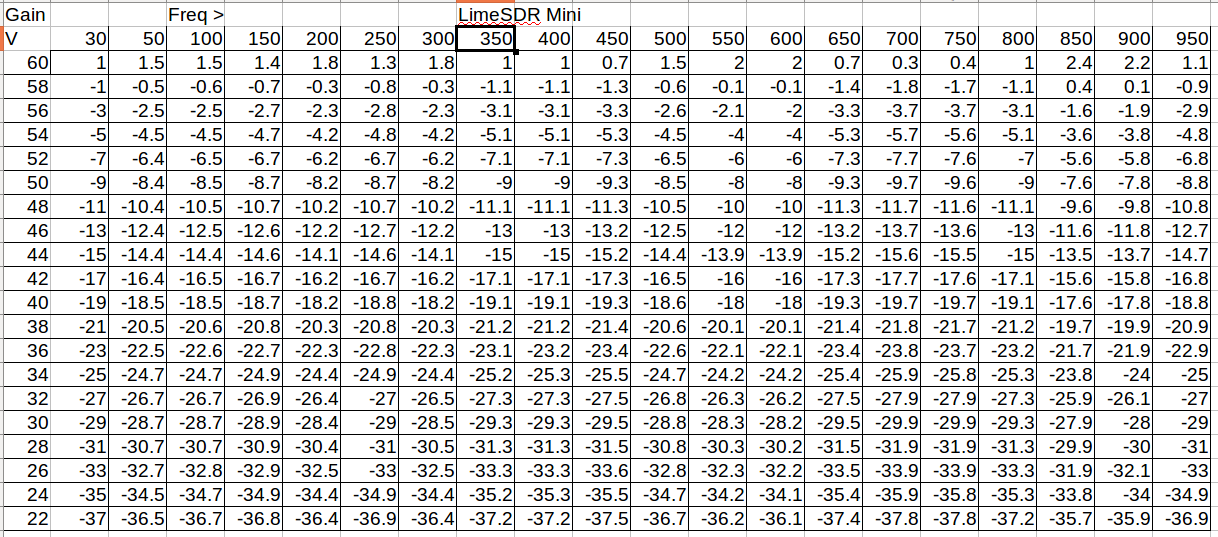LimeSDR-Mini TX Gain Power: Difference between revisions
No edit summary |
m (→Test Setup) |
||
| (3 intermediate revisions by the same user not shown) | |||
| Line 1: | Line 1: | ||
GNU Radio and the LimeSDR Sink block of gr-limesdr were used to | GNU Radio 3.8 and the LimeSDR Sink block of gr-limesdr were used to generate the following data. An attempt was made to determine output power of the LimeSDR-Mini across various settings for Tx Gain in GNU Radio. The following graphs show the results. It is worthwhile to note that, due to time constraints, the data recorded for 30MHz is less precise than for the other frequencies. | ||
== Charts and Graphs == | == Charts and Graphs == | ||
Data was recorded from 50MHz to 950MHz for each 50MHz increment, and | Data was recorded from 50MHz to 950MHz for each 50MHz increment, and a less precise measurement was made at 30MHz. Gain values were tested from 60 (the maximum allowed) down to 22. With the exception of 30MHz, the dBm output was recorded to 0.1dBm, and for each measurement an effort was made to observe the slight variations in power and select the nearest 0.1dBm increment closest to the center of the fluctuation. 30MHz was recorded to the nearest 1dBm. | ||
[[File:LimeSDR-Mini_GNU_Radio_Tx_Power,_dBm_v_MHz.png]] | [[File:LimeSDR-Mini_GNU_Radio_Tx_Power,_dBm_v_MHz.png]] | ||
| Line 12: | Line 12: | ||
[[File:LimeSDR-Mini_GNU_Radio_Tx_Power_Data.png]] | [[File:LimeSDR-Mini_GNU_Radio_Tx_Power_Data.png]] | ||
== Test Setup == | == Test Setup == | ||
The LimeSDR-Mini Tx port was hooked up via 6 inch SMA cable to a SMA/UHF adapter, and the SMA/UHF adapter was directly hooked to a UHF/Type N adapter. The UHF/Type N adapter was plugged into an Agilent CXA N9000A Signal Analyzer. The GNU Radio flowgraph was set up to have the LimeSDR-Mini transmit a 600Hz sine wave at the | A Raspberry Pi 3 running Arch Linux was used, with the LimeSDR-Mini receiving power separately from a powered USB hub. The LimeSDR-Mini Tx port was hooked up via 6 inch SMA cable to a SMA/UHF adapter, and the SMA/UHF adapter was directly hooked to a UHF/Type N adapter. The UHF/Type N adapter was plugged into an Agilent CXA N9000A Signal Analyzer. The GNU Radio flowgraph was set up to have the LimeSDR-Mini transmit a 600Hz sine wave at the specific frequency and gain combination being tested. | ||
{{Community}} | {{Community}} | ||
Latest revision as of 23:11, 29 October 2019
GNU Radio 3.8 and the LimeSDR Sink block of gr-limesdr were used to generate the following data. An attempt was made to determine output power of the LimeSDR-Mini across various settings for Tx Gain in GNU Radio. The following graphs show the results. It is worthwhile to note that, due to time constraints, the data recorded for 30MHz is less precise than for the other frequencies.
Charts and Graphs
Data was recorded from 50MHz to 950MHz for each 50MHz increment, and a less precise measurement was made at 30MHz. Gain values were tested from 60 (the maximum allowed) down to 22. With the exception of 30MHz, the dBm output was recorded to 0.1dBm, and for each measurement an effort was made to observe the slight variations in power and select the nearest 0.1dBm increment closest to the center of the fluctuation. 30MHz was recorded to the nearest 1dBm.
Test Setup
A Raspberry Pi 3 running Arch Linux was used, with the LimeSDR-Mini receiving power separately from a powered USB hub. The LimeSDR-Mini Tx port was hooked up via 6 inch SMA cable to a SMA/UHF adapter, and the SMA/UHF adapter was directly hooked to a UHF/Type N adapter. The UHF/Type N adapter was plugged into an Agilent CXA N9000A Signal Analyzer. The GNU Radio flowgraph was set up to have the LimeSDR-Mini transmit a 600Hz sine wave at the specific frequency and gain combination being tested.
| |||||||||||||||||||||


